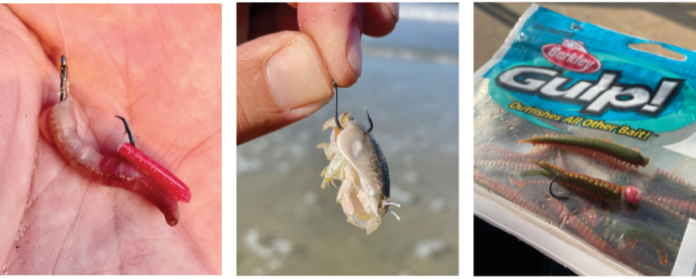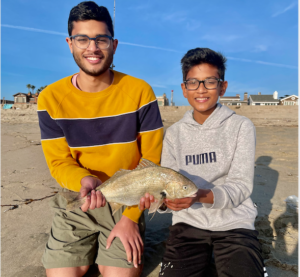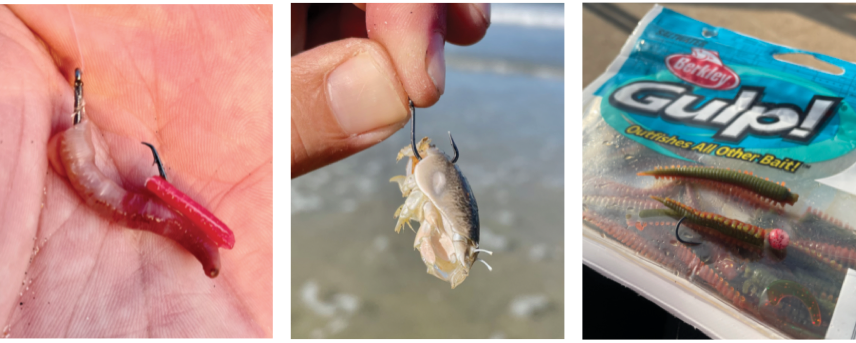
You see and hear some funny things on the beaches in California. There’s always the guy who tells you about the record albacore he caught off the pier in 1981, or the 10-pound corbina they definitely lost last week. I’ve heard some good fishing stories.
Most recently on the sand, I crossed paths with a gentleman wielding a sportfishing combo rigged with a large white blob, dropshot-style, complete with treble hook. I enquired as to the nature of his bait, “Marshmallows, they worked real good last time out…” In the surf? “Sure did!”
With that he walked off, leaving me with many, many questions.
This encounter set me thinking about how lots of people get the size and type of bait they use in the surf so wrong at this time of year. I’m particularly thinking about anglers chasing surfperch and croaker – common targets up and down the SoCal coast.
Let’s start with the size of bait. My buddy’s ping-pong ball-size marshmallow bait was

clearly ridiculous but, more usually, a common mistake is to think that a big slab or ball of bait is going to be the winning ticket for that trophy surf fish. For some species like shark or rays, I’m a big fan of something large and fresh for hook bait, but for a busy day’s general surf fishing on the beach and a nice fish count, small is best in winter and spring.
This is a view I’ve developed after running countless guided sessions targeting fish like surfperch, corbina and spotfin croaker – an experience where time and time again, a tiny bait trips up the biggest fish. During summer, I now specifically seek out the fingernail-size sand crabs (or smaller) and not the big grape or even walnut-size crabs. In winter, I use small sections of a Gulp! Sandworm grub, a 1- to 1.5-inch piece, or a tiny strip of artificial Fishbites and find these far out-fish anything else. Real bloodworm is also a favorite and a small section is always the winning ticket compared to a whole one.
By contrast, the angler loading a big J hook up with as much clam meat or bloodworm as they can fit on is asking for missed bites and rejection by some fairly picky species like the spotfin croaker. One factor that I think comes into play on some of the busier SoCal beaches is that they see a lot of angling pressure and I would guess that, by the time they’ve reached a decent size, they’ll have seen a few hooks and baits. They likely know the danger signs and avoid anything unnatural. Also, a small bait gets inhaled cleanly, leaving the hook to do its work once inside.
So, let’s talk specifics about what baits are doing the business right now, based on what got bit during a recent guided surf trip. The biggest fish of the day, a beautiful spotfin croaker, fell to a 1-inch section of fake sandworm (the ever-reliable Berkley Gulp! Sandworm in camo) on a size four J-hook fished close to the shorebreak, bait-and-wait style. The rest of the fish – a mix of barred surfperch and yellowfin croaker – all fell to sandworm baits too, with a small section proving an easy mouthful for a range of perch sizes.
During the session, we ran two bait-and-wait rods with high-low rigs featuring a section of Fishbites or squid strip on the top hook and walnut-size chunk of squid on the bottom hook. The squid received zero attention whilst the top hook, unusually, picked up a sanddab but that was it. All the meaningful fish fell to slender baits in the 1- to 1.5-inch range fished on 4- or 8-pound fluorocarbon close to the shore. This tracks with past experiences.
With particular reference to the spotfin croaker (one of my favorite species), I’ve found that their preference for small baits has been very consistent over the past few seasons and I wasn’t surprised it ate a tiny sandworm bait close to shore. I usually catch them on things like a small section of bloodworm or a thumbnail-size sand crab with anything bigger failing to do the business. Corbina, during summer, also show a noticeable preference towards small baits, with my biggest guided corbina from last year falling to a tiny bunch of baby sand crabs on a size 8 hook.

Why this apparent preference for small baits? I have an overarching theory that both species have developed an impressive ability to detect and hunt the tiny food items that populate California beaches. The standard sand crab is no bigger than a peanut, the average sandworm you’ll dig up is built like a matchstick and the clams are usually the size of a pea. This is what they live off on a daily basis. They are not frequently coming across a golf ball-size chunk of something to eat. By using small baits, we are simply replicating their natural food sources and providing them with a bait they won’t think twice about before inhaling.
Also, a small bait requires a small hook and light line, which is far less likely to be detected by their eagle eyes compared to a heavier leader and bigger hook. I’ve rarely caught spotfin on anything heavier than 12-pound fluorocarbon and a size 4 hook. For corbina, the combination of a size 8 hook and 4 or 6-pound fluorocarbon has been the ticket in recent seasons. Yellowfin croaker and surfperch seem less fussed but I still notice an increase in hits on lighter tackle.
So, if you’re chasing something sizeable off the beaches this winter and wonder why it’s not happening, I’d look at your bait choices, size and rigging. Keeping it small and subtle pays dividends.




